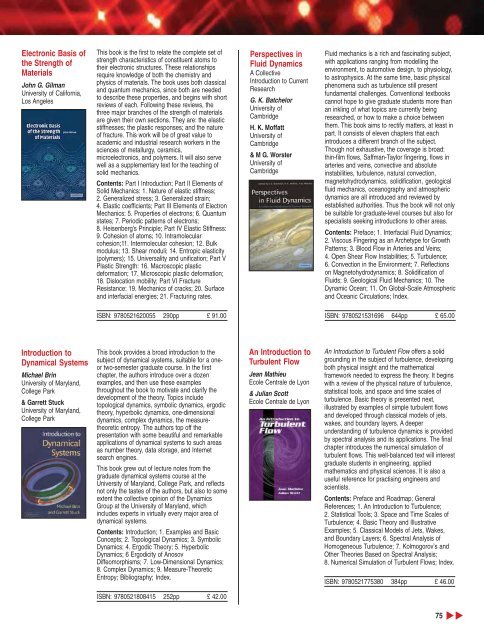ENGINEERING - Cambridge University Press India
ENGINEERING - Cambridge University Press India
ENGINEERING - Cambridge University Press India
Create successful ePaper yourself
Turn your PDF publications into a flip-book with our unique Google optimized e-Paper software.
Electronic Basis of<br />
the Strength of<br />
Materials<br />
John G. Gilman<br />
<strong>University</strong> of California,<br />
Los Angeles<br />
This book is the first to relate the complete set of<br />
strength characteristics of constituent atoms to<br />
their electronic structures. These relationships<br />
require knowledge of both the chemistry and<br />
physics of materials. The book uses both classical<br />
and quantum mechanics, since both are needed<br />
to describe these properties, and begins with short<br />
reviews of each. Following these reviews, the<br />
three major branches of the strength of materials<br />
are given their own sections. They are: the elastic<br />
stiffnesses; the plastic responses; and the nature<br />
of fracture. This work will be of great value to<br />
academic and industrial research workers in the<br />
sciences of metallurgy, ceramics,<br />
microelectronics, and polymers. It will also serve<br />
well as a supplementary text for the teaching of<br />
solid mechanics.<br />
Contents: Part I Introduction; Part II Elements of<br />
Solid Mechanics: 1. Nature of elastic stiffness;<br />
2. Generalized stress; 3. Generalized strain;<br />
4. Elastic coefficients; Part III Elements of Electron<br />
Mechanics: 5. Properties of electrons; 6. Quantum<br />
states; 7. Periodic patterns of electrons;<br />
8. Heisenberg’s Principle; Part IV Elastic Stiffness:<br />
9. Cohesion of atoms; 10. Intramolecular<br />
cohesion;11. Intermolecular cohesion; 12. Bulk<br />
modulus; 13. Shear moduli; 14. Entropic elasticity<br />
(polymers); 15. Universality and unification; Part V<br />
Plastic Strength: 16. Macroscopic plastic<br />
deformation; 17. Microscopic plastic deformation;<br />
18. Dislocation mobility; Part VI Fracture<br />
Resistance: 19. Mechanics of cracks; 20. Surface<br />
and interfacial energies; 21. Fracturing rates.<br />
Perspectives in<br />
Fluid Dynamics<br />
A Collective<br />
Introduction to Current<br />
Research<br />
G. K. Batchelor<br />
<strong>University</strong> of<br />
<strong>Cambridge</strong><br />
H. K. Moffatt<br />
<strong>University</strong> of<br />
<strong>Cambridge</strong><br />
& M G. Worster<br />
<strong>University</strong> of<br />
<strong>Cambridge</strong><br />
Fluid mechanics is a rich and fascinating subject,<br />
with applications ranging from modelling the<br />
environment, to automotive design, to physiology,<br />
to astrophysics. At the same time, basic physical<br />
phenomena such as turbulence still present<br />
fundamental challenges. Conventional textbooks<br />
cannot hope to give graduate students more than<br />
an inkling of what topics are currently being<br />
researched, or how to make a choice between<br />
them. This book aims to rectify matters, at least in<br />
part. It consists of eleven chapters that each<br />
introduces a different branch of the subject.<br />
Though not exhaustive, the coverage is broad:<br />
thin-film flows, Saffman-Taylor fingering, flows in<br />
arteries and veins, convective and absolute<br />
instabilities, turbulence, natural convection,<br />
magnetohydrodynamics, solidification, geological<br />
fluid mechanics, oceanography and atmospheric<br />
dynamics are all introduced and reviewed by<br />
established authorities. Thus the book will not only<br />
be suitable for graduate-level courses but also for<br />
specialists seeking introductions to other areas.<br />
Contents: Preface; 1. Interfacial Fluid Dynamics;<br />
2. Viscous Fingering as an Archetype for Growth<br />
Patterns; 3. Blood Flow in Arteries and Veins;<br />
4. Open Shear Flow Instabilities; 5. Turbulence;<br />
6. Convection in the Environment; 7. Reflections<br />
on Magnetohydrodynamics; 8. Solidification of<br />
Fluids; 9. Geological Fluid Mechanics; 10. The<br />
Dynamic Ocean; 11. On Global-Scale Atmospheric<br />
and Oceanic Circulations; Index.<br />
ISBN: 9780521620055 290pp £ 91.00<br />
ISBN: 9780521531696 644pp £ 65.00<br />
Introduction to<br />
Dynamical Systems<br />
Michael Brin<br />
<strong>University</strong> of Maryland,<br />
College Park<br />
& Garrett Stuck<br />
<strong>University</strong> of Maryland,<br />
College Park<br />
This book provides a broad introduction to the<br />
subject of dynamical systems, suitable for a oneor<br />
two-semester graduate course. In the first<br />
chapter, the authors introduce over a dozen<br />
examples, and then use these examples<br />
throughout the book to motivate and clarify the<br />
development of the theory. Topics include<br />
topological dynamics, symbolic dynamics, ergodic<br />
theory, hyperbolic dynamics, one-dimensional<br />
dynamics, complex dynamics, the measuretheoretic<br />
entropy. The authors top off the<br />
presentation with some beautiful and remarkable<br />
applications of dynamical systems to such areas<br />
as number theory, data storage, and Internet<br />
search engines.<br />
This book grew out of lecture notes from the<br />
graduate dynamical systems course at the<br />
<strong>University</strong> of Maryland, College Park, and reflects<br />
not only the tastes of the authors, but also to some<br />
extent the collective opinion of the Dynamics<br />
Group at the <strong>University</strong> of Maryland, which<br />
includes experts in virtually every major area of<br />
dynamical systems.<br />
Contents: Introduction; 1. Examples and Basic<br />
Concepts; 2. Topological Dynamics; 3. Symbolic<br />
Dynamics; 4. Ergodic Theory; 5. Hyperbolic<br />
Dynamics; 6 Ergodicity of Anosov<br />
Diffeomorphisms; 7. Low-Dimensional Dynamics;<br />
8. Complex Dynamics; 9. Measure-Theoretic<br />
Entropy; Bibliography; Index.<br />
An Introduction to<br />
Turbulent Flow<br />
Jean Mathieu<br />
Ecole Centrale de Lyon<br />
& Julian Scott<br />
Ecole Centrale de Lyon<br />
An Introduction to Turbulent Flow offers a solid<br />
grounding in the subject of turbulence, developing<br />
both physical insight and the mathematical<br />
framework needed to express the theory. It begins<br />
with a review of the physical nature of turbulence,<br />
statistical tools, and space and time scales of<br />
turbulence. Basic theory is presented next,<br />
illustrated by examples of simple turbulent flows<br />
and developed through classical models of jets,<br />
wakes, and boundary layers. A deeper<br />
understanding of turbulence dynamics is provided<br />
by spectral analysis and its applications. The final<br />
chapter introduces the numerical simulation of<br />
turbulent flows. This well-balanced text will interest<br />
graduate students in engineering, applied<br />
mathematics and physical sciences. It is also a<br />
useful reference for practising engineers and<br />
scientists.<br />
Contents: Preface and Roadmap; General<br />
References; 1. An Introduction to Turbulence;<br />
2. Statistical Tools; 3. Space and Time Scales of<br />
Turbulence; 4. Basic Theory and Illustrative<br />
Examples; 5. Classical Models of Jets, Wakes,<br />
and Boundary Layers; 6. Spectral Analysis of<br />
Homogeneous Turbulence; 7. Kolmogorov’s and<br />
Other Theories Based on Spectral Analysis;<br />
8. Numerical Simulation of Turbulent Flows; Index.<br />
ISBN: 9780521775380 384pp £ 46.00<br />
ISBN: 9780521808415 252pp £ 42.00<br />
75

















